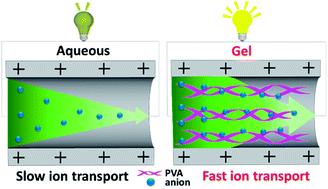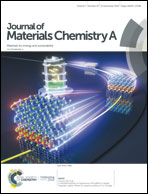A nanofluidic osmotic power generator demonstrated in polymer gel electrolytes with substantially enhanced performance†
Abstract
Polymer gel electrolytes have shown potential for enhancing operation stability and cycle longevity in energy storage devices; however, their use in osmotic power conversion remains unexplored, because one would expect reduced ionic conductance at the nanoscale, which in turn can impact their performance output. Here we report the first polymer gel electrolyte-based osmotic power generator by introducing polyvinyl alcohol (PVA) as a solid matrix. We present the experimental evidence showing that with the PVA gel electrolyte, the ion transport and osmotic power can be enhanced under conditions in which the electric double layer overlap effect in nanochannels is significant; thus, a substantial increase of the power output as high as nearly two times can be achieved as compared to the corresponding aqueous electrolytes. The observations are explained by the adsorption of excess counterions onto PVA confined at the nanoscale, supported by our modeling performed using the modified Poisson and Nernst–Planck equations by considering a charged PVA layer in a nanochannel. The system presented offers a new avenue toward the exploitation of high-performance and safe osmotic power generators.



 Please wait while we load your content...
Please wait while we load your content...